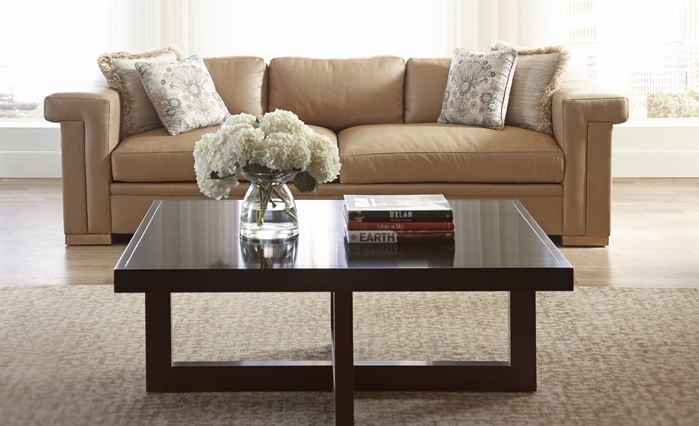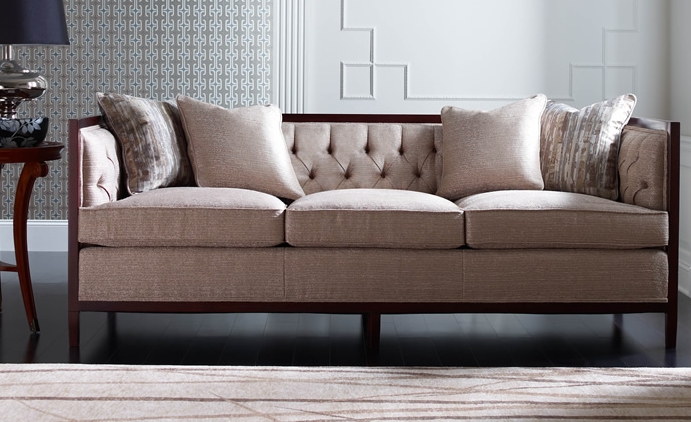This article has been republished with the permission of Furniture Today USA.
For some time, case goods resources have been placing both wood species and finish front and center, letting lower sheen finishes captivate consumers with a dramatic wood story.
Words: Thomas Russell
The result has been a casual design aesthetic that appears at both ends of the design spectrum, from traditional to clean-lined contemporary forms.
The trend is perhaps just as visible on the high end, where such approaches have created a sense of liveable luxury in bedroom, dining and occasional furniture. Particularly in the dining and living categories, this has allowed consumers to use what was once relegated mainly to special occasions on an everyday basis.
“It doesn’t say ‘just look at me, I am just for display,’” said Aminy Audi, president and CEO of Stickley Furniture. “It is to be enjoyed by every member of the family.”
One example of this casual everyday-living approach can be seen in the Stickley Studio collection, which updates the Stickley line with more contemporary forms and finishes.
Pieces such as dining and occasional tables are made with solid ash and feature open-grain finishes including Sand, Fieldstone, Lodge and Night. These all accentuate the dramatic natural wood grains of the ash, giving pieces a highly textured look and feel.
“It is very well-designed and has construction features that are unique strong and made to last,” Audi said of the casual style direction. “Finish is a very important aspect of it. It is very durable and easy to care for and acquires a certain patina with age.”
Alex Shuford III, CEO of the Rock House Farm family of brands that includes Century, Highland House, Hancock & Moore, Jessica Charles and Cabot Wrenn, said that, in general, today’s consumer is moving to a lifestyle where they feel comfortable using all areas of the home on a daily basis. This is also illustrated in the prevalence of open floor plans that seamlessly meld kitchen, dining and living room areas of the home.
He added that the trend is being dictated partly by younger homeowners that are starting families.
“They don’t like living in a space where some of it feels unusable,” he said. “This is really a change in the way Americans live. And I don’t think it is going to swing back in the other direction. … We have moved toward this in fits and starts over time, but now it is more consistent.”
Complementing this lifestyle is the use of woods such as oak and ash that are more casual by their natural wavy grain patterns that take well with clear and open-grain finishes.
Shuford added that the casual lifestyle approach is also seen in more distressed paint finishes and mixed media elements such as casual stone and rustic distressed metals.
“I want something that feels nice, but is durable day in and day out,” Shuford said of consumers’ changing attitudes. “If it gets a scratch on it, it does ruin the piece.”
Greg Harden, president and CEO of Harden Furniture, said that the trend is toward casual furniture at all price points.
“The industry went from traditional to transitional in a relatively short period of time, and … the interpretation of transitional is very much casual,” he said, adding that there are looks his company is offering that would not have been seen at Harden 10 years ago.
“I would say that we were always considered to be a more formal, traditional line, so the transition to a very different design genre maybe took us a little longer,” he said, pointing to more causal elements in its Mount Vernon collection such as hand-planed tops and softer finishes. “I don’t think there is anything we are working on now that isn’t relatively casual.”
He added that this is being driven partly by a younger generation of customers, but also an older demographic who is “looking at things that are more liveable — furniture they can live with, not have to live up to.”
In the Harden line, he also pointed to Artistry, a clean-lined collection made with quarter sawn solid white ash. Artistry has been in the line for about 10 years but has been updated with newer, more casual finishes that are lighter in tone than some of the more heavily pigmented tones of years past.
“We always try, with new finishes, to give them a lot of transparency so you can get a lot of look with the wood grain,” Harden said.
“The open grain really works. Any finish with an open grain works well because it makes it more casual.”
Laura Holland is vice president of marketing and communications for Heritage Home Group, the parent company for Henredon, Hickory Chair, Drexel Heritage and Thomasville, among others. She noted that in the past, luxury was synonymous with shiny hardware and high-sheen finishes — not to mention more formal shapes.
“While there is still a customer out there for that, there are a lot of people who don’t want their home to be formal. They want it to be a place where they can be comfortable,” she said. “People want it to be beautiful and have it feel luxurious, and they want to pamper themselves, but they don’t want to be afraid living with this beautiful furniture.”
And while the company has maintained its selection of quality materials such as mahogany solids and veneers, the finishes are lower in sheen, noted Kevin Bowman, vice president of sales for Heritage Home Group’s luxury brands. Yet even those relaxed finishes offer a clarity and depth, he added.
“You never see a muddy finish from us,” he said, noting that the company approaches the application of each finish as an art, not as a formula. “We never try to hide anything. We are applying the finish to each piece uniquely depending on the beauty of the veneer.”
Dan Bradley, president and CEO of high-end case goods and upholstery manufacturer Chaddock, said many luxury consumers still like great forms whether they are traditional or transitional in design. However, they also like finishes that are both “resilient and liveable.”
“You can take any piece in our line and make it casual luxury,” he said, referencing the many lower sheen looks among its 65 finish options. These, too, are available with no distressing, up to minimal, medium and heavy distressing levels.
“We are seeing transitional product typically finished in higher sheens being finished in lower sheens with distressing,” Bradley said. “They are quite beautiful, and we seem to be getting more and more interest in that.”
He said use of wood species also can turn a more formal look into something that is more casual.
“We can take a Mary McDonald or Larry Laslo formal dining set and put oak on it and some distressing, and it’s a completely different piece of furniture,” Bradley said, adding that cerused and wire-brushed looks add to the resiliency of the finish.
Of casual trends in case goods, Vanguard President Andy Bray explained, “Today’s casual designs tend to be simpler, without the flourishes of fluted pilasters, acanthus leaves and carved volutes that typified 18th-century styling.
“The scale is just as large, if not larger, to accommodate spacious rooms. The finishes tend to be softer, with less sheen,” he added. “But they are equally complex and often have the same number of layers as your grandmother’s 18th-century dining table.
He noted that one example of a typical casual finish in the Vanguard line that appeals to consumers across the country is Barrington — a soft grey with undertones of black and brown.
“It is complex and interesting, but it is liveable. It is neutral enough to go with nearly any paint colour, but still reflects the luxurious wood grains and cathedrals of fine veneers, just more subtly. It’s sort of like a drinkable wine. It’s probably just as expensive and has the same complexity, but it feels more natural to drink.”




